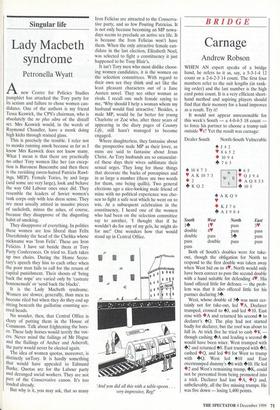BRIDGE
Carnage
Andrew Robson
WHEN AN expert speaks of a bridge hand, he refers to it as, say, a 5-3-1-4 12 count or a 2-6-2-3 14 count. The first four numbers refer to the suit lengths (in rank- ing order) and the last number is the high card point count. It is a very efficient short- hand method and aspiring players should find that their memory for a hand improves as a result. Try it!
It would not appear unreasonable for this week's South — a 4-0-4-5 18 count to force his partner to choose a trump suit outside •s? Yet the result was carnage:
Dealer South North-South Vulnerable South West North East 1+ 14 pass
double 44 pass pass double pass 54 pass pass pass double pass pass
Both of South's doubles were for take- out, though the obligation for North to respond to the first double was taken away when West bid on to 4V. North would only have been correct to pass the second double with a hand suitable for defending 41I. His hand offered little for defence — the prob- lem was that it also offered little for his partner declaring 544.
West, whose double of 54 was most cer- tainly not for take-out, led •A. Declarer trumped, crossed to 4g, and led 410. East rose with *A and returned his second 4 to declarer's 4Q. The play had not started badly for declarer, but the roof was about to fall in. At trick five he tried to cash 4K though cashing 44A and leading a second 44 would have been wiser. West trumped with 42 and returned 48. East trumped with 445, cashed •Q, and led 48 for West to trump with 4Q. West led 410 and East overtrumped dummy's 46 with 410. He led 42 and West's remaining trump, 4K, could not be prevented from being promoted into a trick. Declarer had lost 4A, 40 and, unbelievably, all the five missing trumps. He was five down — losing 1,400 points.


















































































 Previous page
Previous page